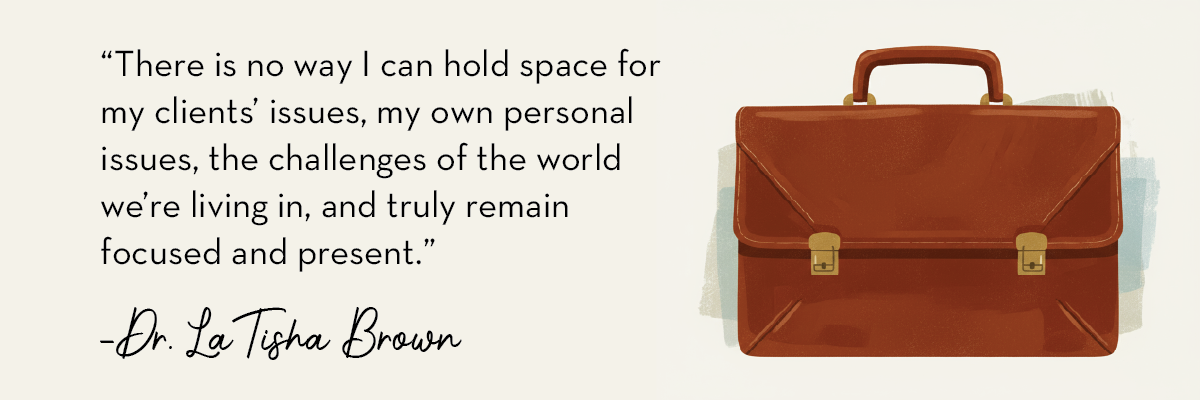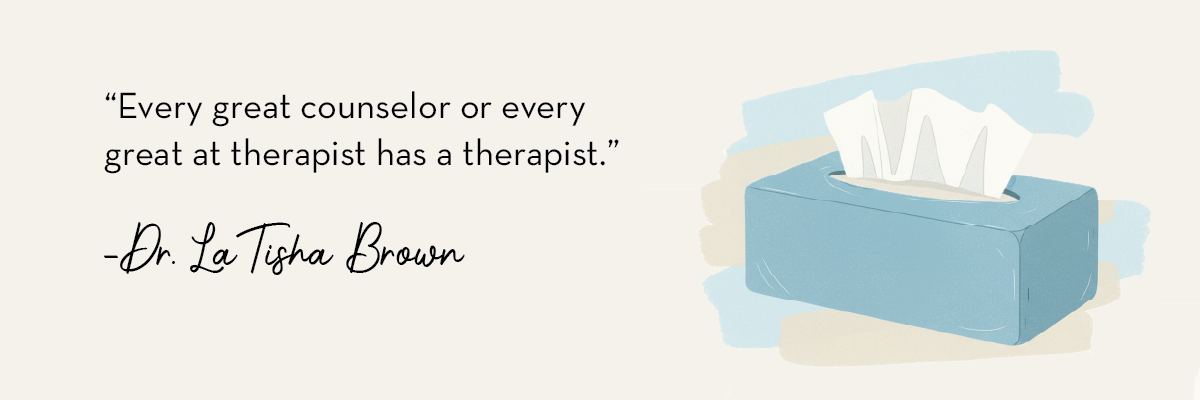Counselors are trained to care for others, but the work takes an emotional toll. Here’s how they stay grounded through personal therapy, supervision, and peer support.
BY LORI S. ALCALÁ
The best days as a mental health counselor start long before a session begins, when there’s been quiet, calm, and space to prepare. For LaTisha Brown, Ph.D., core faculty member for the Counseling Department at Saybrook University, those are the days when she arrives with clarity and energy. “I’ve gotten adequate rest the night before, having taken care of my needs,” she says. “I enjoy my work so much, which is why I’m the one who typically brings the joy, sunshine, and positive energy to the session.”
Not every day feels that way, though. There are times when the weight of client work makes it harder to focus.

“There is no way I can hold space for my clients’ issues, my own personal issues, the challenges of the world we’re living in, and truly remain focused and present,” Dr. Brown says.
Her experience reflects what many students in clinical mental health programs understand early: Counseling is emotionally demanding work. Whether sitting with someone in crisis or working through one’s own internal pressures, counseling is about showing up with one’s full self intact. “Really paying attention to who you are, both in session and out of session, is so important,” Dr. Brown says.
Students training to become clinical mental health counselors often experience the intensity of the work during their very first field placements. That’s why learning to manage those demands is so important. Through supervision, peer support, personal therapy, and boundaries, counselors can stay emotionally present and effective long after that first session.

Why Mental Health Counselors Face Emotional Strain
Therapists don’t just listen to client stories of trauma and hardship; they experience them, offering clarity and holding space for people in pain. Given that they must also deal with their own issues, sometimes the work becomes deeply personal.
Jennifer Preston, Ph.D., program director of Counselor Education and Supervision at Saybrook, has experienced just how personal the work can become. She was working in a domestic violence shelter with a woman who had entered with serious injuries. The client’s court date came weeks later, and although she still showed some visible signs of abuse, the judge ruled that she was no longer in danger. As a result, the restraining order was denied and criminal charges dropped.
“What was most painful about it was her fear-based response,” recalls Dr. Preston. Shaken, Dr. Preston went home that night unsure if she could keep doing the work, but she came back the next day, despite not agreeing with the judge’s decision.
Moments like these are all too common.
Alfonso Ferguson, Ph.D., core faculty member for the Counseling Department at Saybrook and executive director at GoodWerk, recalls a particularly challenging time from early in his private practice. He had used humor in a session, something that had helped build rapport with clients before. This time, though, the client took offense and had an emotional breakdown that took 20 minutes to work through.
Reflecting on how the incident made him evolve his thinking, Dr. Ferguson says, “It made me really consider, ‘Do I not get to show up as myself? Do I need to do something different? Do I need to be different? What am I doing wrong?’” Looking back on it, he says, “It felt heavy.”
The internal pressure to always say the right thing, to always help, is something many students feel early on. Many counselors suffer from burnout and compassion fatigue according to the American Counseling Association. What matters is how therapists learn to process these emotions and how they come to understand that they don’t have to be perfect to be effective.

Why Self-Care Is Essential for Therapists and Counselors
For Dr. Brown, the ability to show up begins with what happens outside her practice. She sees a therapist every other week and protects her mornings from chaos. She’s also intentional about what she eats, what she watches, and with whom she surrounds herself. She recalls a quote she read long ago that has stuck with her throughout her career: “Every great counselor or every great therapist has a therapist.”

However, Dr. Brown emphasizes that self-care is also about learning limits. She asks herself, “How do I put boundaries in place that are also going to impact my own mental health and care?”
Like Dr. Brown, Dr. Ferguson has found his own rhythm. He makes time for creativity on weekends and prioritizes regular travel with his partner. When he experiences stress in his personal life, he’s mindful of how it might affect his client work. “I’m always making sure I have space to manage my own emotional needs so those things don’t bleed into my therapeutic experiences with clients,” he says.

Dr. Ferguson also uses a trusted peer network for support, a kind of “whisper network” that consists of off-the-record check-ins, venting sessions, and informal supervision among friends and colleagues. “We almost offer each other peer supervision. I went to folks, and I was able to process and make sense of what was mine to hold or not,” he explains.
For some counselors, simply having a calming object nearby can make a big difference in how they’re able to show up for their patients. Dr. Preston keeps a smooth stone with an etched thumb groove in her pocket during sessions, and she travels with one on planes. “There’s a sort of automatic response,” she says, “just to regulate my nervous system a little bit.” It helps her cope in stressful moments, even without needing to pause or explain what’s happening.
All three experts agree: Self-care isn’t a nice-to-have; it’s what makes the work possible.

How Counseling Students Build Emotional Resilience
Saybrook University teaches more than counseling. We help students understand how to thrive in even the most challenging situations. Through 700 hours of fieldwork, including practicum and internships, our M.A. in Counseling: Clinical Mental Health Counseling Specialization program encourages students to engage with the emotional side of clinical work, including through online class discussions.
“Students have conversations in classes that can be challenging and uncomfortable,” Dr. Preston says. “They also work with peers and faculty to learn how to regulate, including what to do to stay grounded in those conversations.”
Dr. Preston notes that part of the training program also involves helping students figure out what kind of therapist they want to be, what environments they want to work in, and what boundaries they need to set for themselves.
“The overall approach is to help students discover their own boundaries and capacities, while equipping them with the self-care tools necessary to sustain the work long term,” she explains.

What Counselors Need To Know About Managing Emotional Burnout
Drs. Ferguson and Brown both say that having support outside of work is essential. While Dr. Ferguson makes time for creativity, travel, and connection, Dr. Brown emphasizes letting go of the need to be perfect. “Counselors have to understand that they are not required to be perfect and that their healing can also be parallel to their clients,” she says.

Dr. Brown encourages counselors to “take off the cape” and stop feeling like they must be “super counselor” by saving both their clients and themselves. The same is true for boundaries. “I don’t want to be so great for my clients that I have nothing left in my cup to give to the very people that mean the absolute most to me, and that is my family,” she says.
Dr. Ferguson advises future counselors to think beyond the therapy session itself and consider the systems, personal and societal, that affect everyone involved in the work. “I’ve been really leaning into Bronfenbrenner's ecological systems model,” he says, “how all those different things trickle down and impact us as people.”
This broader view helps Dr. Ferguson understand clients more completely rather than seeing them in isolation. It also helps him step back from making everything about his own role as a therapist and keeps the focus on what clients actually need.

Why Therapist Self-Care Is Key to Client Care
Like everyone else, mental health counselors feel things deeply. It’s part of what makes them good at what they do. However, to stay in this work, they must care for themselves as intentionally as they care for others.
That all starts in training. At Saybrook, self-awareness and support aren’t just part of the curriculum; they’re part of our culture. If you’d like to learn more about Saybrook’s M.A. in Counseling program, complete the form below or apply today through the Saybrook University application portal.



























